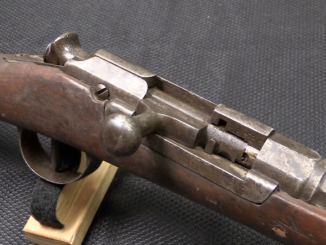Today’s video – and many others – have been made possible in part by my friend Shéhérazade (Shazzi) Samimi-Hoflack. She is a real estate agent in Paris who specializes in working with English-speakers, and she has helped me arrange places to stay while I’m filming in France. I know that exchange rates make this a good time for Americans to invest in Europe, and if you are interested in Parisian real estate I would highly recommend her. She can be reached at:
(Note: she did not pay for this endorsement)
Immediately upon the liberation of France in 1944, the French military began a process of developing a whole new suite of small arms. As it applied to SMGs, the desire was for a design in 9mm Parabellum (no more 7.65mm French Long), with an emphasis on something light, handy, and foldable. All three of the French state arsenals (MAC, MAS, and MAT) developed designs to meet the requirement, and today we are looking at the first pair of offerings form Chatellerault (MAC). These are the 1947 pattern, a very light lever-delayed system with (frankly) terrible ergonomics.
Many thanks to the French IRCGN (Criminal Research Institute of the National Gendarmerie) for generously giving me access to film these unique specimens for you!




Here in southwest France in the area between Angouleme and Perigueux and Riberac to the south
Oridour s/glane to the north there is amazing resistance history and good gun shows
House prices are less then half those of Paris and with the fast train TGV you can be in Paris in 2 1/2 hours
A fascinating look at two long-forgotten French prototype SMGs!
These guns were actually based on Châtellerault’s pre-war prototype submachine gun, the Type ETVS, which competed (unsuccessfully) against St. Étienne’s SE-MAS Mle 35 – which was of course adopted as the MAS Mle 38. The Type ETVS was designed by one Captain Martin as a compact gun for tank crews, which is evident even here in the post-war version. Most exterior aspects of the Type ETVS were identical to the MAC Mle 47, except for the stock which was made from wood.
After the failure of the MAC Mle 47, Châtellerault developed two more prototypes, known as the MAC Mle 48 and the MAC Mle 48 LS. The Mle 48 was similar to the Sten but had a very unusual stock design, whereas the Mle 48 LS had a compacting wireframe stock and was probably the most logical SMG design Châtellerault ever made. The MAC Mle 48 LS reportedly was issued for field trials in Indochina in the late 40s/early 50s but was not adopted.
Châtellerault is also said to have developed the first prototypes of the Rexim Favor submachine gun during WW2, under the direction of Colonel Paul Favier, but the plans were allegedly stolen by a woman working for the resistance and the project was abandoned. Favier fled to Switzerland after the war and sold the design to Rexim S.A.
Magnifique! I must say that I’m very, very grateful to find Ian doing this video on these forgotten prototypes, and also to read @Get_Em_Puppy’s reply, since his excellent and informative website is about the only information about these SMG designs.
http://firearms.96.lt/pages/E.T.V.S..html
The Etablissement Technique de Versailles prototype had all of the features of this gun, except for the Pal Kiraly Hungarian engineer, firearm technician lever-delayed blowback and a wood instead of metal stock, correct? Also, was the ETVS prototype in the 7,65x20mm Long cartridge, or was it a 9mm Parabellum prototype?
I’m sensing there was more continuity than change between the designs, although clearly the first one used an M-3-type charging crank instead of the triggerguard lever. The United States, as everyone knows, dispensed with the M-3 charging handle since it was liable to be caught on things, or even get bent or break off, in favor of the famous “finger notch” in the bolt on the M3A1.
Elsewhere, @ Get_Em_Puppy noted of the MAC Mle. 1947 prototypes:
“A rotating recoil spring that ran across the width of the lower receiver rather than being housed in the rear length of the receiver. The bolt was moved by a swinging lever that was actuated by the rotation of the recoil spring, operating on a torsion action.
A hinge-type cocking handle that was located underneath the trigger guard, which was folded forward to cock the weapon.
A compacting magazine housing that could fold under the length of the barrel when the weapon was stowed; it could not be fired in this position.
A hinged magwell cover that closed the magazine feed from dirt when the weapon was not loaded.
A folding wireframe stock that featured a metal brace fitted to its mid-section; when the stock was folded, the brace would lay over the ejection port to seal it from dirt.”
Certainly while it sure looks like an uncomfortable, and even painful firearm to shoot with, it sure is sealed up rather nicely against the elements… Almost intuitive to fold and unfold in comparison with Ian’s Hotchkiss SMG!
I can see that the innovations of lever-delayed blowback to keep the weight down went out the window in favor of the MAT-49’s robustness and excessive weight… Reliability and long-service clearly militated against the lighter gun.
Is it the case that the braided-wire operating spring–mimicking the “mouse trap” spring of the Kalashnikov’s trigger mechanism, but doing comparatively greater work with the reciprocating bolt–was a real weakness of the design? I’ve read that such a spring would lose temper and/or break or weaken over time in comparison to the nearly ubiquitous coiled spring used in “tube gun” designs.
I sure hope Ian films an episode on the MAC Mle. 1948 prototypes! I’m pretty interested in the first prototype with the weird stock and all.
“(…)Also, was the ETVS prototype in the 7,65x20mm Long cartridge, or was it a 9mm Parabellum prototype?(…)”
According to https://forum.axishistory.com/viewtopic.php?p=594568&sid=11eac1f0482a309587e9cdb96ab73888#p594568
Pistolet Mitrailleur Type ETVS – German : Maschinenpistole 721(f) –
…
Caliber : 7.65×22 mm Longue
“(…)“mouse trap” spring(…)”
Spring designed to get input in form of torque are named torsion
https://en.wikipedia.org/wiki/Torsion_spring
Spacibo! Thank you! Better to know the correct nomenclature: torsion spring. But is the torsion spring as a “main spring” in a blowback firearm a particularly bad idea?
96 Page is down!
🙁
Given the total fascination w/ folding submachineguns the French had at this time, one surmises former members of the Resistance were on the selection boards.
The French fascination with compacting submachine guns actually predates the war; in the 1930s they tested both the Type ETVS and SACM Mle 39 submachine guns which both had folding magazine housings. This was a feature pioneered by the Hungarian engineer Pál Király during his tenure at SIG (he had a hand in the SIG MKMO, BSA-Király, and Danuvia 39.M which all had folding mags). The Italians also dabbled with this; during their 1943 SMG trials they tested at least two folding submachine guns, the FNA-B and Isotta Fraschini models.
The SACM Mle. 1939 had a removable butt, a bit like the Sten, no?
An important feature of the folding magazine well is that it serves as an important safety mechanism, removing live cartridges from the feedway, as Ian noted in his short about these guns… If a blowback-operated firearm falls and strikes a hard surface, the momentum can cause the bolt to move back far enough to strip-off a cartridge from the magazine and fire it… The Gnome et Rhone R5 Sten copy had an extra mechanism to prevent this rather than the “safety” slot that a lot of tubular blowback SMGs used. Others had a bolt handle or knob that could be pushed into the receiver to “lock” the bolt forward. The German MP40 at times had a leather strip attached around the chamber that looped over the reciprocating bolt handle to keep it “forward.”
“(…)SACM Mle. 1939 had a removable butt, a bit like the Sten, no?(…)”
For photo of Pistolet Mitrailleur Modèle 1939 with stock removed see 2nd image from top in https://guns.fandom.com/wiki/Petter_Mle_1939
Observe that unlike Sten Mark II, this weapon has pistol grip which stays even after detaching stock, therefore it seems better suited for firing in stock-less configuration.
Quite so. Thanks. But not a folder. Just completely removable, albeit retaining a pistol grip. There was a separate pistol grip designed for the Sten, but it does not appear if it was ever manufactured in quantity let alone “issued.”
The first version seems to have borrowed the stock layout from the Canadian built version of the Sten MK II, and the cocking handle from the U.S. M3.
The second version’s cocking system was improved, assuming that lever doesn’t flip back and forth as the bolt moves. But the stock is one I’d expect to be almost impossible to use correctly, without either having no cheek weld at all, or ending up needing stitches.
A production version should probably have retained the first version of the stock and the second cocking setup.
As for the French Army’s interest in folding SMGs, it was simple. They wanted them for the paratroops, rather like we developed the M1A1 carbine with its folding stock. The idea, as Edwin Tunis once said, was so the paras could land shooting instead of waiting for their weapons to come down on the next elevator.
cheers
eon
Paratroopers is one explanation for the infatuation for folding SMGs, but it’s not the only reason. The idea was originally conceived in the first place to make SMGs easier to carry while slung across the shoulder. Long SMG magazines tended to jut into the user’s back if they were carried whilst loaded, so SIG devised the folding magazine housing as a method of allowing the magazines to lay flat against the user’s back during carry.
Then during the 1930s, the French Army became interested in the idea of folding SMGs to make them easier to carry in confined spaces, because at that time they still considered the SMG to be more of a tanker’s personal defence weapon rather than a staple of the infantry arsenal.
This looks like it could have been developed into an emergency self defence weapon for aircrew. Compact and light for stowage, decent 9mm cartridge, the cost and poor handling are less important for a niche weapon. The Russians issue a 9mm SMG to their pilots, better than a near useless pistol.
9mm smg?? What is the name of it (if it exists).
“(…)name(…)”
PP-2000 https://armourersbench.com/2023/10/08/russian-pilots-fielding-pp-2000s-plk-pistols/